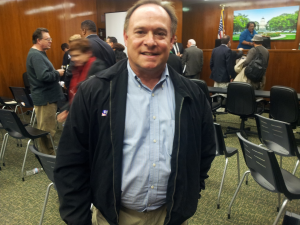
East County educators among those testifying
By Jordan Schaffner
December 11, 2013 (San Diego)--Assemblywoman Shirley Weber (photo, left, with staff) held a public hearing on access to San Diego higher education on November 21st in San Diego. Highlights from the hearing included statements from educators at both private and public institutions, identifying needs to be met for local students.
Among the issues discussed including diversity, overcrowding, and a need for a new higher education campus in our region.
Private institutions included the University at San Diego (USD) attempted to prove that they encourage diversity by providing statistics to help the African American community, but in Shirley Weber’s estimation, those diversity efforts have been anemic. According to California Competes (http://californiacompetes.org) , a state run organization for developing practices and policies in higher education, African Americans have the lowest college attendance of any ethnic group with only 427 students at the University of California San Diego (UCSD), 1189 at San Diego State University (SDSU) and 357 at Cal State San Marcos. At private local universities, minority students only make up 34% of the population, while whites comprise 55%. However, there are 10,072 Asian students at UCSD.
By nature, private schools are more expensive, according to http://insidebiz.com/news/profit-colleges-accused-deceptive-practices, sometimes with deceptive advertising and lower graduation or employment rates, luring poor minority students and others to take out more costly student loans and work part time, or attend public institutions instead. Therefore they don’t really meet the needs of the underserved minority population and employers in the areas well.
When asked what plans her office has to meet the needs of East County higher education, Assemblymember Weber stated that she will be holding more hearings regarding the subject.
Public institutions including East County’s Grossmont and Cuyamaca community colleges were also represented, because they have a better chance to fill the need for skilled workers.
Grossmont College French teacher David Milroy (photo, right)  spoke to the pane, about the fact that two-year college instructors do not keep office hours, which can be a critical factor for student success. This is utilized at universities such as UCSD quite extensively.
spoke to the pane, about the fact that two-year college instructors do not keep office hours, which can be a critical factor for student success. This is utilized at universities such as UCSD quite extensively.
He spoke in contrast to a formidable amount of Chula Vista community representatives, who made a presentation to use higher education dollars to build a university in Chula Vista that will integrate an innovation district within the community. For a moment, because they claimed that the South Bay is the second fastest growing community in the country, a Chula Vista University seemed inevitable. Then the panel was reminded that Antelope Valley may need a University instead because there are very few schools there.
Greg Barr, a former history teacher at Grossmont and Cuyamuca College and member of the district’s school board, stated that Proposition 30 helped out quite a bit with overcrowded classrooms, but other challenges remain. It’s hard to make a case for a Chula Vista University because according to http://californiacompetes.org, the Inland Empire has very low community college participation, and the San Joaquin Valley is made up of adults who have the fewest degrees and is the poorest in the state, from Stockton to Bakersfield. So these factors will have to be evaluated.
Weber, a career educator before her election to the Assembly, made a point that her office had to recently approve many H1 visas to meet the needs of immigrants who have been hired to work here in San Diego by employers that require them because of the lack of skilled workers in town. She indicated that the resources allocated to do this would be better utilized in the future by providing higher education classes, so that these employers will have the skilled workforce they require and more local jobs will be provided to the community.
She also spoke about the possibility of bringing another CalTech type of university to the state, because the need to approve those visas for immigrant workers recently “is a sign of reality…that we need to do a better job at preparing skilled workers.” She added that she doesn’t plan to approve these visas again.
Community colleges also serve the growing ex-convict population—people who desperately need to develop marketable skills in order stay out of prison with programs such as alternative energy courses and medical assistant certifications. But as Assemblymember Weber noted, “Sometimes you solve a problem and create another problem.”
All and all, her office has a lot on their plate; she concluded that more hearings will be needed to make the best financial allocations.













Recent comments